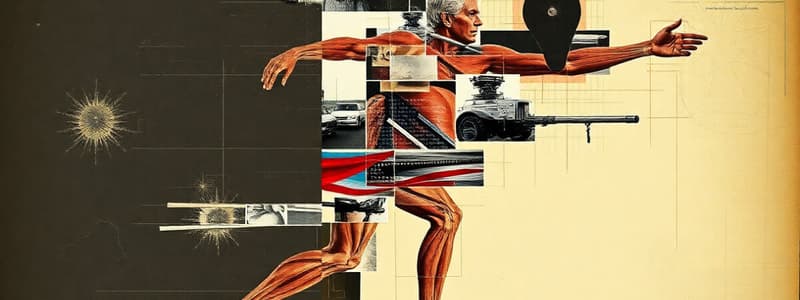Podcast
Questions and Answers
What primary aspect does neuromechanics focus on in understanding human motion?
What primary aspect does neuromechanics focus on in understanding human motion?
- Parallel processing in cognitive functions
- Nutritional influences on muscle development
- Psychological factors affecting physical performance
- Dynamics of body, muscles, sensory organs, and control systems (correct)
Which application is NOT a direct focus of neuromechanics?
Which application is NOT a direct focus of neuromechanics?
- Nutritional supplement development (correct)
- Restoring lost movement function
- Exercise prescription to enhance performance
- Prosthetic design
Which concept is essential for understanding muscle mechanics within the field of neuromechanics?
Which concept is essential for understanding muscle mechanics within the field of neuromechanics?
- Moment arms and torque (correct)
- Muscle fiber type differentiation
- Cognitive load theory
- Eccentric contraction type
What type of control is involved in spinal cord regulation of locomotion?
What type of control is involved in spinal cord regulation of locomotion?
Which of the following does NOT typically affect muscle force production during movement?
Which of the following does NOT typically affect muscle force production during movement?
What comprises a motor unit?
What comprises a motor unit?
Why might the innervation number differ among various muscles?
Why might the innervation number differ among various muscles?
Which statement accurately reflects the role of the motor neuron?
Which statement accurately reflects the role of the motor neuron?
What is the average innervation number observed in the abductor digiti minimi muscle?
What is the average innervation number observed in the abductor digiti minimi muscle?
In the context of motor units, which statement is true regarding the distribution of motor unit forces?
In the context of motor units, which statement is true regarding the distribution of motor unit forces?
What is the role of calcium in muscle contraction?
What is the role of calcium in muscle contraction?
Which statement correctly describes the cross-bridge cycle?
Which statement correctly describes the cross-bridge cycle?
How does electromyography (EMG) relate to muscle force?
How does electromyography (EMG) relate to muscle force?
What initiates the power stroke during muscle contraction?
What initiates the power stroke during muscle contraction?
What is the function of differential electrodes in electromyography?
What is the function of differential electrodes in electromyography?
Flashcards are hidden until you start studying
Study Notes
Neuromechanics
- Neuromechanics is the study of how the body, muscles, sensory organs, and nervous system work together to control movement.
Motion Analysis
- Motion analysis involves using tools like electromyography (EMG) to analyze muscle activity and understand how the nervous system controls movement.
Applications of Neuromechanics
- Neuromechanics is used in various fields for performance enhancement, rehabilitation after injury, and prosthetic/exoskeleton design.
Muscle Mechanics
- Muscle force production, moment arms, and torque are essential components of muscle mechanics.
- Work, energy, and power are also important factors considered in movement analysis.
- Simple reflex control and cortical control of voluntary movement are examples of the nervous system's role in movement.
Muscle Structure and Function
- Muscle fibers are the fundamental units of muscle tissue.
- Excitation-contraction coupling is the process by which a neural signal triggers muscle contraction.
- Calcium ions play a vital role in this process by binding to troponin, which allows myosin heads to bind to actin filaments.
- The cross-bridge cycle is the process by which myosin heads bind to actin filaments, generating force.
- ATP is required for muscle contraction.
Electromyography (EMG)
- EMG measures the electrical activity produced by muscle fibers during contraction, giving information about the muscle's activity.
Motor Units
- A motor unit consists of a single motor neuron and all the muscle fibers it innervates.
- The number of motor units in a muscle varies based on muscle size and function.
- Smaller muscles typically have fewer motor units but higher innervation numbers, while larger muscles have more motor units with lower innervation numbers.
- Higher dexterity muscles tend to have lower innervation numbers, while muscles with lower dexterity have higher innervation numbers.
Motor Unit Types
- Motor units are categorized based on the muscle fiber types they innervate.
- Type I (slow oxidative), Type IIA (fast oxidative), and Type IIX (fast glycolytic) are the primary muscle fiber types.
- Type S (slow twitch, fatigue resistant), Type FR (fast twitch, fatigue resistant), and Type FF (fast twitch, fatigable) are common motor unit types.
Motor Unit Recruitment
- The Henneman size principle describes how motor units are recruited based on force demand: smaller motor units are recruited first, followed by larger ones as the force requirement increases.
- Rate coding refers to increasing the force output of a single motor unit by increasing its discharge rate.
- EMG can be used to assess how motor unit recruitment and rate coding contribute to muscle force production.
Studying That Suits You
Use AI to generate personalized quizzes and flashcards to suit your learning preferences.


